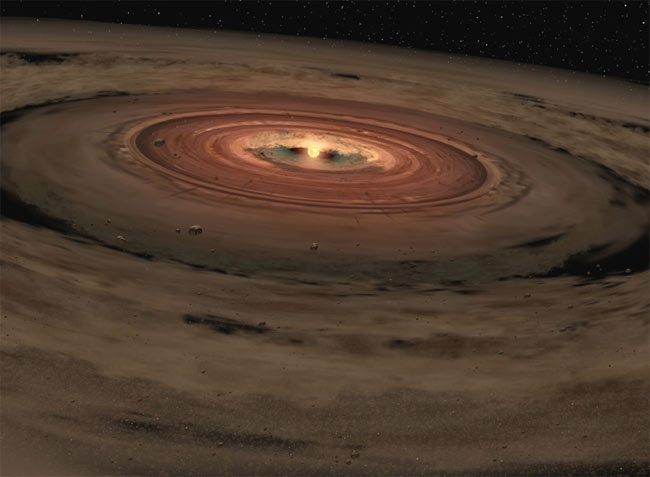Water Vapor Hints at Planets Forming Around Nearby Stars

Scientistshave detected water vapor in the spinning disks that surround two newly formedstars, where planets are born.
A team ofresearchers spotted the water molecules in disks of dust and gas around DR Tauand AS 205A, which are around 457 light-years and 391 light-years, respectively,away from Earth.
The spinningdisks of particles may eventually coalesce to formplanets.
Thediscovery, set for publication in the March 20 issue of the AstrophysicalJournal Letters, brings scientists one step closer to understanding water'srole in Earth-likeplanet formation.
"Thisis one of the very few times that water vapor has been detected in the innerpart of a protoplanetary disk ? the most likely place for terrestrial planetsto form," said lead researcher Colette Salyk, a graduate student ingeological and planetary sciences at Caltech.
Waterdetection
Salyk andher colleagues analyzed light-emission data captured by NASA's Spitzer SpaceTelescope, finding spikes of brightness at certain wavelengths known to signalthe presence of water vapor. "Only Spitzer is capable of observing theseparticular lines in a large number of disks because it operates above Earth'sobscuring water-vapor-rich atmosphere," Salyk said.
Get the Space.com Newsletter
Breaking space news, the latest updates on rocket launches, skywatching events and more!
Using thisdata along with more detailed information collected with instruments on theKeck II Telescope in Hawaii, the team estimated the speed and location of the watervapor molecules. "They were moving at fast speeds," Salyk said,"indicating that they came from close to the stars, which is where Earth-likeplanets might be forming."
As to howmuch water, the researchers have detected only a small amount so far, they say.
"Whilewe don't detect nearly as much water as exists in the oceans on Earth, we seeonly a very small part of the disk ? essentially only its surface ? so theimplication is that the water is quite abundant," said co-researcherGeoffrey Blake, professor of cosmochemistry and planetary sciences at Caltech.
Formingplanets
Thewater-vapor findings could indicate that planets are forming around the stars.
Forinstance, Jupiter formed in our solarsystem as its gravitational field trapped icy solids spinning in the outerpart of the sun's planetary disk. Before Jupiter gained much mass, these sameicy solids could have traveled toward the star and evaporated to produce watervapor such as that seen around DR Tau and AS 205A.
Theresearchers have not detected icy solids around the recently studied stars."Our observations are possible evidence for the migration of solids in thedisk," Salyk said. "This is an important prediction of planet-formingmodels."
Theseinitial observations portend more to come. "We were surprised at how easyit is to find water in planet-forming disks once we had learned where to look,"said study team member Klaus Pontoppidan, a Caltech postdoctoral scholar andplanetary scientist. "It will take years of work to understand the detailsof what we see."
- Solar System Like Ours Found
- Top 10 Most Intriguing Extrasolar Planets
- Video: Planet Hunters
Join our Space Forums to keep talking space on the latest missions, night sky and more! And if you have a news tip, correction or comment, let us know at: community@space.com.

Space.com is the premier source of space exploration, innovation and astronomy news, chronicling (and celebrating) humanity's ongoing expansion across the final frontier. Originally founded in 1999, Space.com is, and always has been, the passion of writers and editors who are space fans and also trained journalists. Our current news team consists of Editor-in-Chief Tariq Malik; Editor Hanneke Weitering, Senior Space Writer Mike Wall; Senior Writer Meghan Bartels; Senior Writer Chelsea Gohd, Senior Writer Tereza Pultarova and Staff Writer Alexander Cox, focusing on e-commerce. Senior Producer Steve Spaleta oversees our space videos, with Diana Whitcroft as our Social Media Editor.









